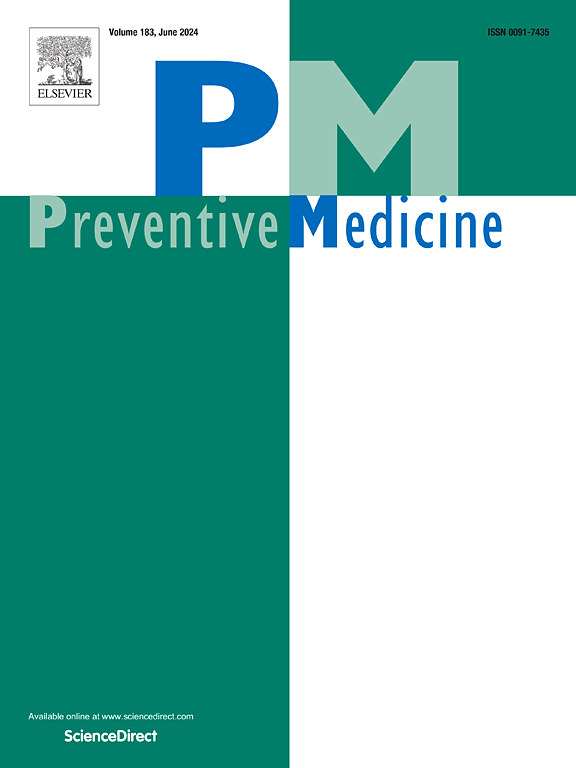Changes in the food environment surrounding schools in four New Jersey school districts between school years 2012–13 and 2019–20
IF 3.2
2区 医学
Q1 MEDICINE, GENERAL & INTERNAL
引用次数: 0
Abstract
Objectives
While public health policies have mostly targeted the food environment within schools, recent research shows that the food environment surrounding schools is also related to children's diet and health outcomes. The goal of this paper was to examine the changes in the food environment around schools from school year 2012–13 to 2019–20 in four New Jersey school districts.
Methods
We analyzed data from 152 kindergarten – 12th grade public schools in Camden, Newark, New Brunswick, and Trenton for 2012–13 to 2019–20. Food outlets within 0.25-mile buffers around schools were classified into convenience stores, limited-service restaurants, small grocery stores, and upgraded convenience stores. Multivariable Poisson and negative binomial regression models were used to evaluate trends in food outlet prevalence over the study period.
Results
The number of convenience stores decreased by 6 % annually (exp(βi) = 0.94, 95 % CI: 0.91; 0.96), while the number of upgraded convenience stores (carrying a selection of healthier items) increased by 30 % annually (exp(βi) = 1.30, 95 % CI: 1.17; 1.44). Other outlet types, such as small grocery stores and limited-service restaurants, remained stable.
Conclusions
Although unhealthy outlets remained the most prevalent, there were improvements in the food environment around schools over the study period. Notably, these changes coincided with local policy initiatives aimed at improving healthy food offerings in convenience stores. Local policies can improve the food environment around schools by increasing access to healthier options. Policies aimed at improving the food environment around schools are crucial for supporting children's health and enhancing the effectiveness of school nutrition programs.
2012-13 学年至 2019-20 学年期间新泽西州四个学区学校周边食品环境的变化。
目标:虽然公共卫生政策主要针对学校内的食物环境,但最近的研究表明,学校周围的食物环境也与儿童的饮食和健康结果有关。本文的目的是研究新泽西州四个学区从2012-13学年到2019-20学年学校周围食品环境的变化。方法:我们分析了卡姆登、纽瓦克、新不伦瑞克和特伦顿的152所幼儿园- 12年级公立学校2012-13年至2019-20年的数据。学校周围0.25英里缓冲区内的食品店被分为便利店、有限服务餐馆、小杂货店和升级便利店。使用多变量泊松和负二项回归模型来评估研究期间食品店患病率的趋势。结果:便利店数量每年减少6 % (exp(βi) = 0.94,95 % CI: 0.91;0.96),而升级的便利店(提供健康食品)的数量每年增加30 % (exp(βi) = 1.30,95 % CI: 1.17;1.44)。其他类型的出口,如小型杂货店和有限服务餐馆,保持稳定。结论:虽然不健康的餐厅仍然是最普遍的,但在研究期间,学校周围的食品环境有所改善。值得注意的是,这些变化与当地旨在改善便利店健康食品供应的政策举措不谋而合。地方政策可以通过增加获得更健康选择的机会来改善学校周围的食物环境。旨在改善学校周围食品环境的政策对于支持儿童健康和提高学校营养方案的有效性至关重要。
本文章由计算机程序翻译,如有差异,请以英文原文为准。
求助全文
约1分钟内获得全文
求助全文
来源期刊

Preventive medicine
医学-公共卫生、环境卫生与职业卫生
CiteScore
7.70
自引率
3.90%
发文量
0
审稿时长
42 days
期刊介绍:
Founded in 1972 by Ernst Wynder, Preventive Medicine is an international scholarly journal that provides prompt publication of original articles on the science and practice of disease prevention, health promotion, and public health policymaking. Preventive Medicine aims to reward innovation. It will favor insightful observational studies, thoughtful explorations of health data, unsuspected new angles for existing hypotheses, robust randomized controlled trials, and impartial systematic reviews. Preventive Medicine''s ultimate goal is to publish research that will have an impact on the work of practitioners of disease prevention and health promotion, as well as of related disciplines.
 求助内容:
求助内容: 应助结果提醒方式:
应助结果提醒方式:


